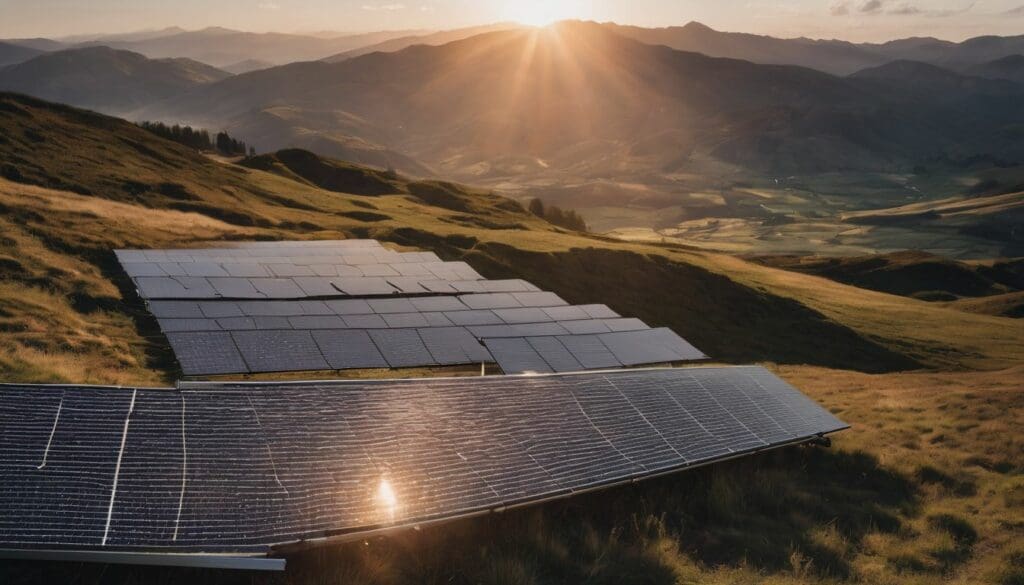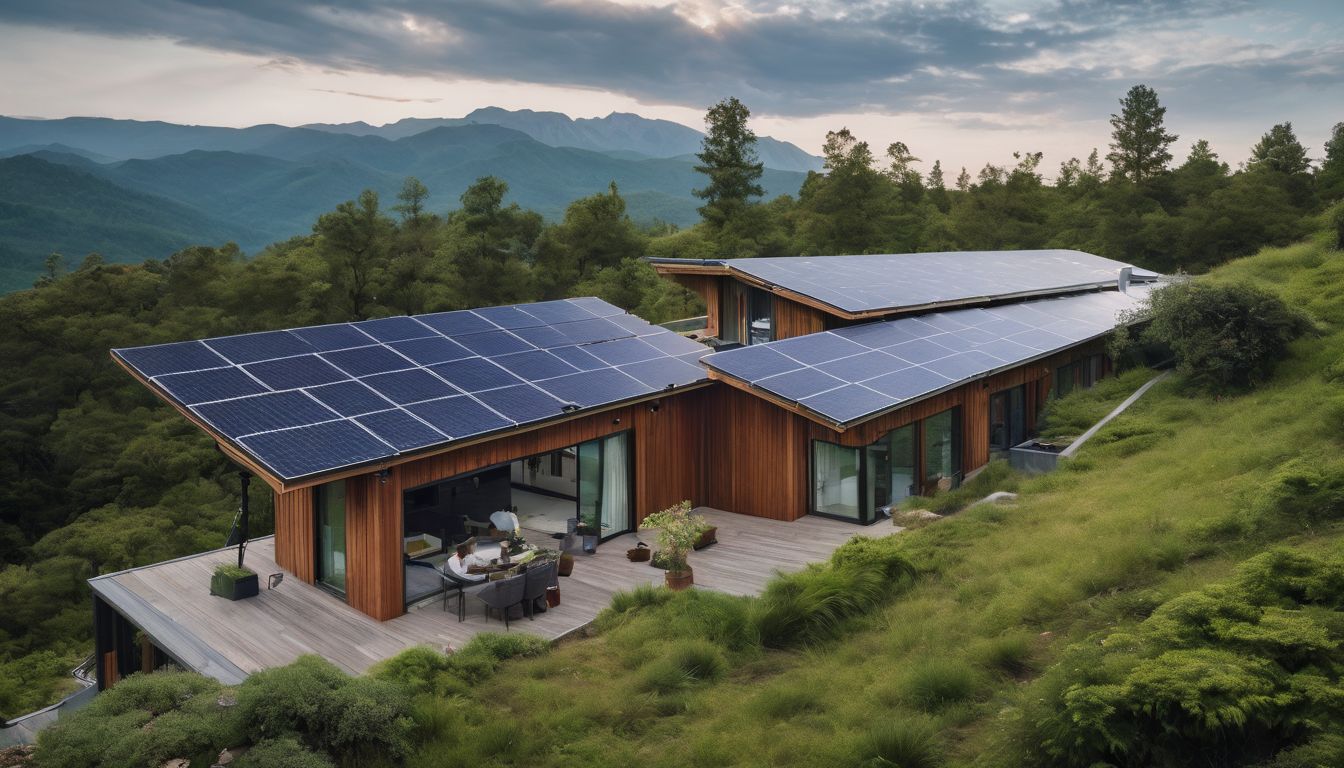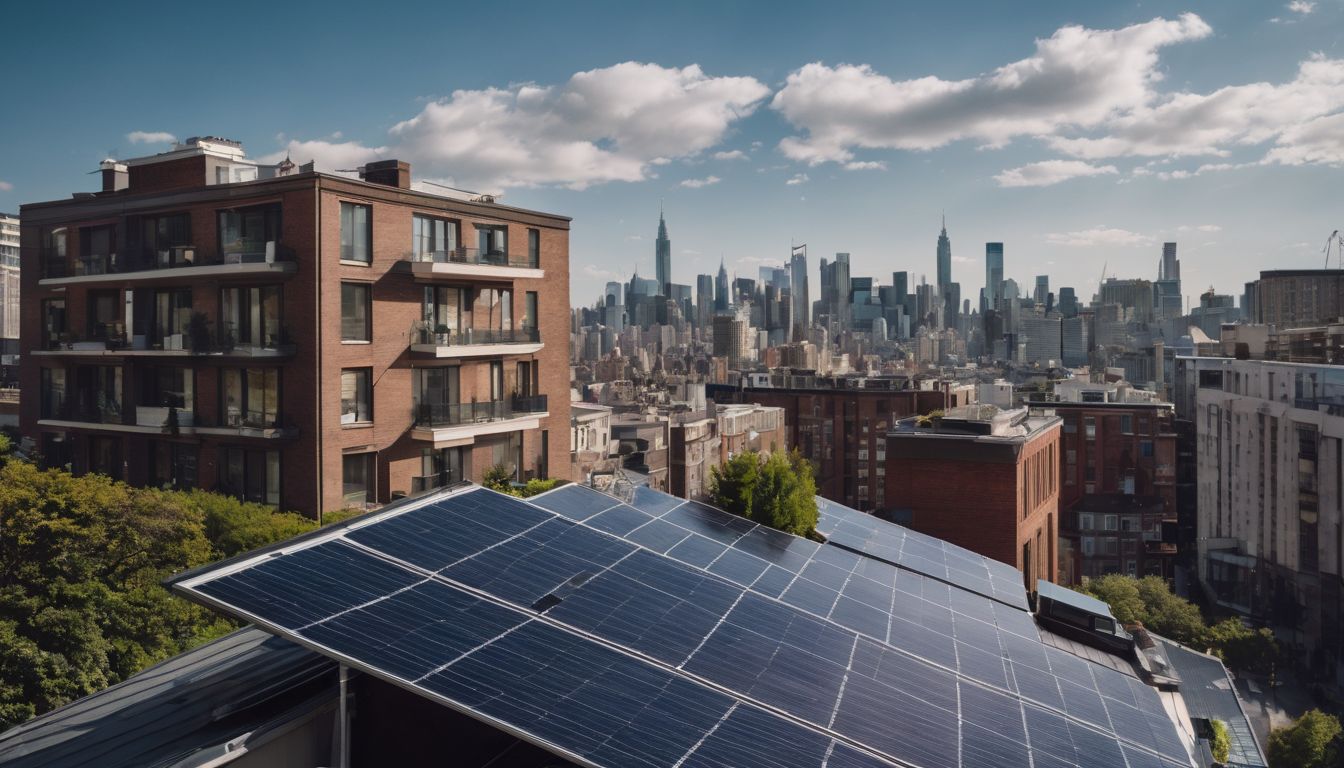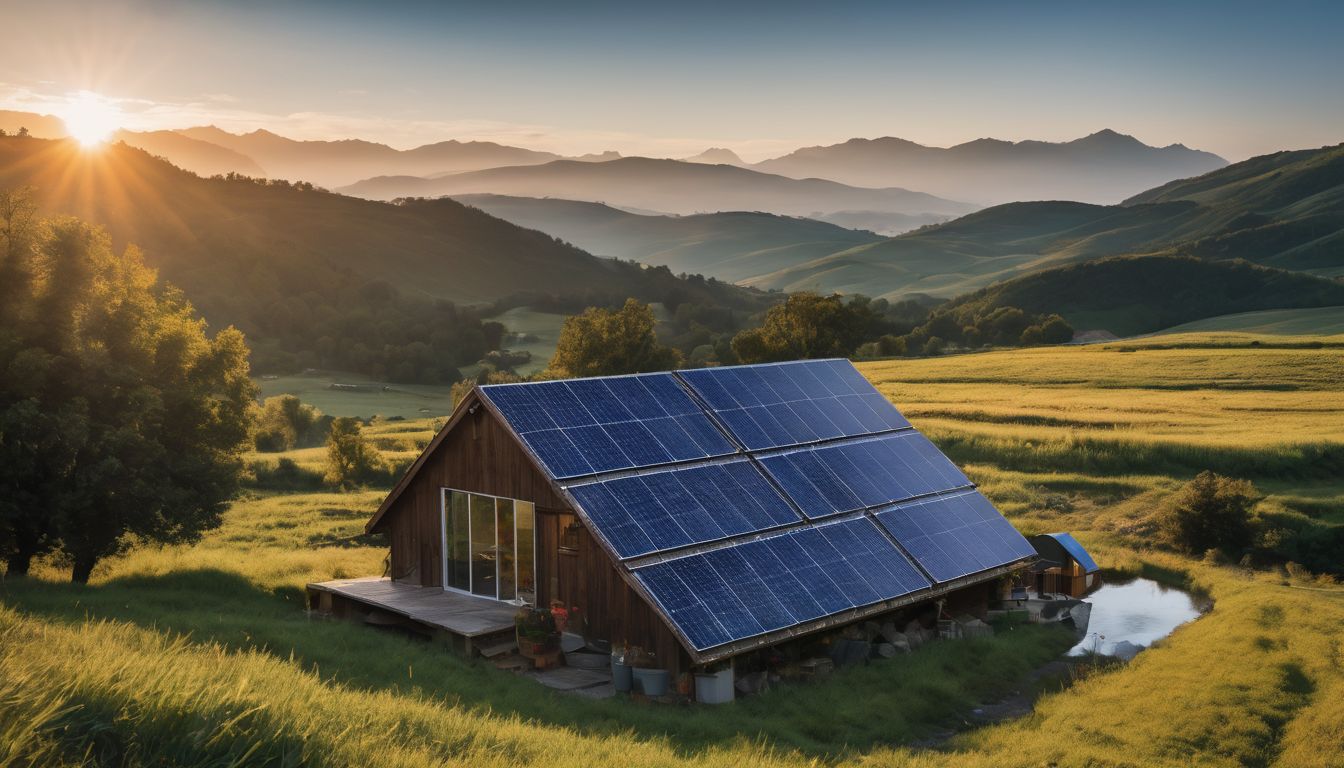Many homeowners wonder why their solar panels aren’t always as efficient as expected. Weather conditions can significantly influence the performance of these energy-harvesting systems.
This article will explain how different weather scenarios affect your solar panels and what you can do to mitigate their impact. Read on for some enlightening facts!
Key Takeaways
- Different weather conditions such as clouds, rain, thunderstorms, snow, hail, and temperature changes can affect the efficiency of solar panels.
- Rain and snow have cleaning benefits for solar panels by washing away dirt and debris which boosts their performance.
- Strong winds can potentially damage solar panels or reduce their effectiveness if not properly installed and maintained.
- After severe weather events like storms or hail it’s important to check your solar panels for any potential damage that may affect their efficiency.
- Monitoring systems like SolarEdge Monitoring and Tesla Powerwall allow you to keep track of your solar panel performance during different weather conditions.
Effects of Weather on Solar Panels and Production
Weather conditions such as clouds, rain, and thunderstorms can decrease the efficiency of solar panels. Additionally, snow, wind, temperature fluctuations, and hail can also impact the production of solar energy.
Clouds, rain, and thunderstorms
Clouds can have a significant effect on solar panel efficiency. They act like a filter, reducing the amount of sunlight that reaches the panels and thus lowering their output. Interestingly, light cloud cover might actually enhance performance by scattering sunlight, which allows more photons to hit the solar cells from different angles.
However, heavy clouds will lead to a drop in power generation as less direct sunlight is available to convert into electricity.
Rain washes away accumulated dust and debris from the surface of solar panels, which can improve their overall efficiency by allowing more light to reach the photovoltaic cells. Yet during rainy days with continuous thick cloud coverage, expect your solar energy production to take a dip.
Thunderstorms present an added challenge for solar panels—they not only block out sunlight with dense clouds but also pose risks due to lightning strikes and potential hail damage.
Despite these factors, state-of-the-art solar systems generally maintain considerable resilience in varied climatic conditions and continue contributing towards sustainable energy goals even during adverse weather events.
Snow
Snow can significantly impact the efficiency of solar panels, as it covers the surface area and reduces sunlight exposure to the photovoltaic cells. During snowy weather conditions, solar panel productivity is hindered, leading to reduced energy output.
Snow accumulation can also affect temperature and lead to a decrease in overall performance. However, some innovative solutions such as tilt mounts or snow-clearing mechanisms can help mitigate these effects and optimise solar panel efficiency in snowy climates.
Understanding how snow affects solar panels helps in making informed decisions when installing and maintaining them. By implementing measures to address snow-related challenges, you can ensure that your solar panel system operates optimally regardless of weather conditions.
Wind
Strong winds can impact the efficiency of solar panels. They can cause movement in the panels, leading to potential damage or reduction in effectiveness. To mitigate these effects, it is important to ensure that solar panel installation is secure and resistant to high winds.
Additionally, regular maintenance checks should be conducted to identify and address any issues related to wind impact on solar panels.
Wind impacts the performance of solar panels by potentially causing damage or reducing their effectiveness. It’s crucial for environmentally conscious individuals who support conservation efforts to consider the implications of wind on their renewable energy sources and take appropriate measures to ensure optimal efficiency.
Temperature
Solar panel efficiency is influenced by temperature. As the temperature increases, solar panels become less efficient in converting sunlight into electricity. On the other hand, as the temperature drops, solar panel efficiency generally increases.
Solar cells operate best at cooler temperatures, so it’s important to consider this factor when evaluating their performance in different weather conditions. The ideal operating temperature range for solar panels usually falls between 25 to 35 degrees Celsius.
Understanding how temperature affects solar panel efficiency is crucial for maximising energy production and making informed decisions about installation and maintenance. Despite challenging weather conditions such as extreme heat or cold, technological advancements continue to improve the overall effectiveness of solar panels in various climates.
Hail
As we consider the impact of weather on solar panel efficiency, it’s important to acknowledge the potential effects of hail. Hailstorms can pose a significant threat to solar panels, causing damage that may reduce their effectiveness.
Large hailstones can lead to cracks or dents in the panels, hindering their ability to harness sunlight and convert it into energy efficiently. It is crucial for individuals with solar panel installations to be aware of this risk and take appropriate measures to minimise potential damage from hail.
While other weather events like rain and snow can have some benefits for solar panels, hail poses a unique challenge due to its potential for physical harm. Monitoring systems such as SolarEdge Monitoring or Tesla Powerwall Monitoring can aid in assessing any damage caused by hailstorms and initiating prompt repairs when necessary.
How Rain and Snow Can Benefit Solar Panels
Rain and snow can benefit solar panels by providing a natural cleaning process. When rain falls, it washes away dust, dirt, and other debris that may have accumulated on the surface of the panels.
This cleansing action helps to maintain optimal sunlight absorption and panel efficiency. Similarly, when snow melts off the panels, it also contributes to cleaning them, ensuring that they can continue to generate electricity effectively.
Additionally, snow can act as an insulator for solar panels during colder temperatures by creating a protective layer over the panels.
In snowy climates, this insulation effect can prevent ice buildup on the surface of the panels and aid in maintaining their functionality throughout winter months. As a result, both rain and snow play essential roles in preserving the performance of solar panels while minimising maintenance requirements.
Potential Damage to Solar Panels During Weather Events
After severe weather events such as storms or hail, it’s important to check for any potential damage to your solar panels. This can include cracks, dents, or any other physical harm that could impact their efficiency.
Check for damage after storms
After storms, it is important to check your solar panels for damage. Here are some steps to follow:
- Inspect the solar panels for any visible damage such as cracks or chips.
- Look for any loose connections or wiring that may have been affected by the storm.
- Check the mounting system to ensure it is secure and undamaged.
- Evaluate the performance of the solar panels to ensure they are still operating at optimal efficiency.
- Consider reaching out to a professional if you notice any significant damage or decrease in performance.
Monitoring Your Solar Panels During Weather Events
Keep an eye on your solar panels during weather events to ensure they are operating efficiently. Utilise solar monitoring systems such as SolarEdge or Tesla Powerwall to track performance and detect any issues.
SolarEdge Monitoring
Monitor your solar panels with SolarEdge Monitoring to track their performance in real-time. This technology allows you to analyse energy production and pinpoint underperforming panels quickly, ensuring maximum efficiency.
You can receive alerts for maintenance issues and potential problems, enabling proactive management of your solar system’s health.
By using SolarEdge Monitoring, you can optimise your solar panel efficiency in different weather conditions. This tool gives you the power to make data-driven decisions when it comes to your renewable energy production.
Stay informed and take action with precise insights from SolarEdge Monitoring.
Tesla Powerwall Monitoring
Transitioning from monitoring your solar panels with SolarEdge to the next level of home energy management, is the capability of Tesla Powerwall Monitoring. This state-of-the-art system allows you to keep a close eye on the performance and status of your home’s energy storage solution.
With real-time data and alerts, you can track the charge and discharge cycles, monitor energy consumption patterns, and make informed decisions about optimising your energy usage.
By harnessing the power of Tesla Powerwall Monitoring, environmentally conscious individuals can take control of their energy consumption habits in an easy-to-understand manner. Whether it’s understanding peak demand times or ensuring efficient use of stored solar energy during adverse weather conditions, this monitoring system empowers homeowners to actively contribute to conservation efforts while reaping the benefits of sustainable living.
Conclusion
In conclusion, monitoring your solar panels during weather events is crucial. Cloudy days and stormy weather affect solar panel efficiency, but rain and snow can also benefit them.
Don’t forget to check for damage after extreme weather, as this could impact the performance of your solar panels. Through proper monitoring and maintenance, you can ensure that your solar panels continue to operate efficiently in varying weather conditions.
FAQs
1. How does weather affect solar panel efficiency?
Weather can greatly influence the output efficiency of solar panels; sunny conditions boost energy production while cloudy days and extreme temperatures can reduce it.
2. Do solar panels still work on cloudy days?
Yes, solar panels do function on a cloudy day but their performance may diminish due to lesser sunlight reaching the photovoltaic technology in the cells.
3. Can high temperatures impact my solar panel’s performance?
Extreme heat can negatively affect your solar panel’s efficiency because as temperature rises, the solar cell efficiency typically decreases.
4. What is the best weather for maximum solar panel output?
Solar panels operate most effectively in sun-drenched weather with moderate climate conditions that keep them within their ideal temperature range.
5. Are there any environmental factors that can harm my solar panels over time?
Yes, long-term exposure to harsh weather patterns like hail or heavy snowfall might damage your panels and reduce energy efficiency.





